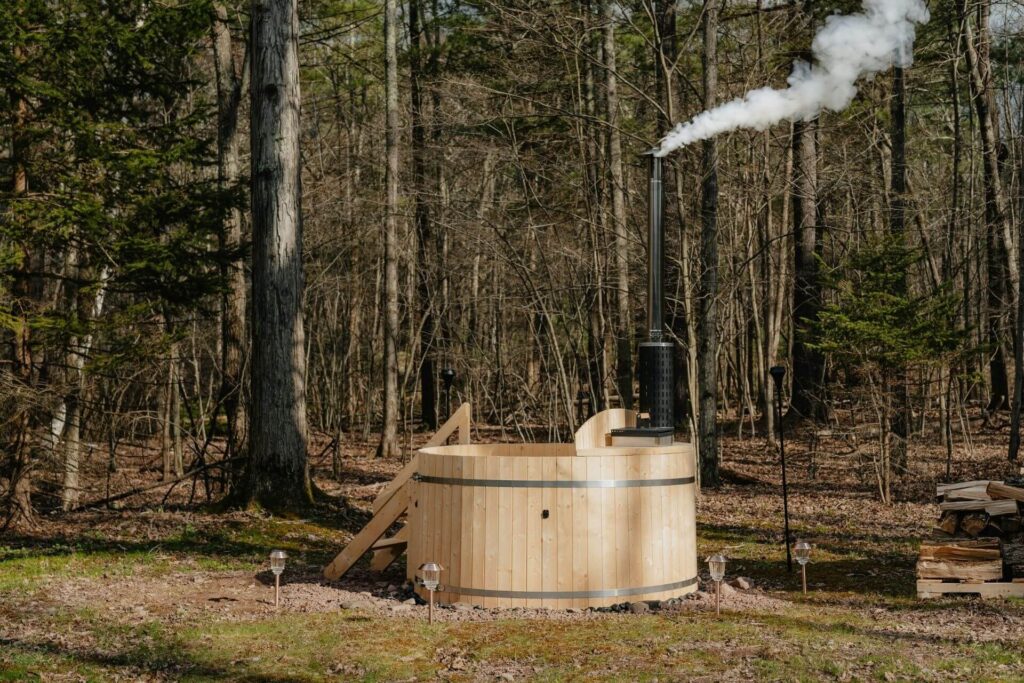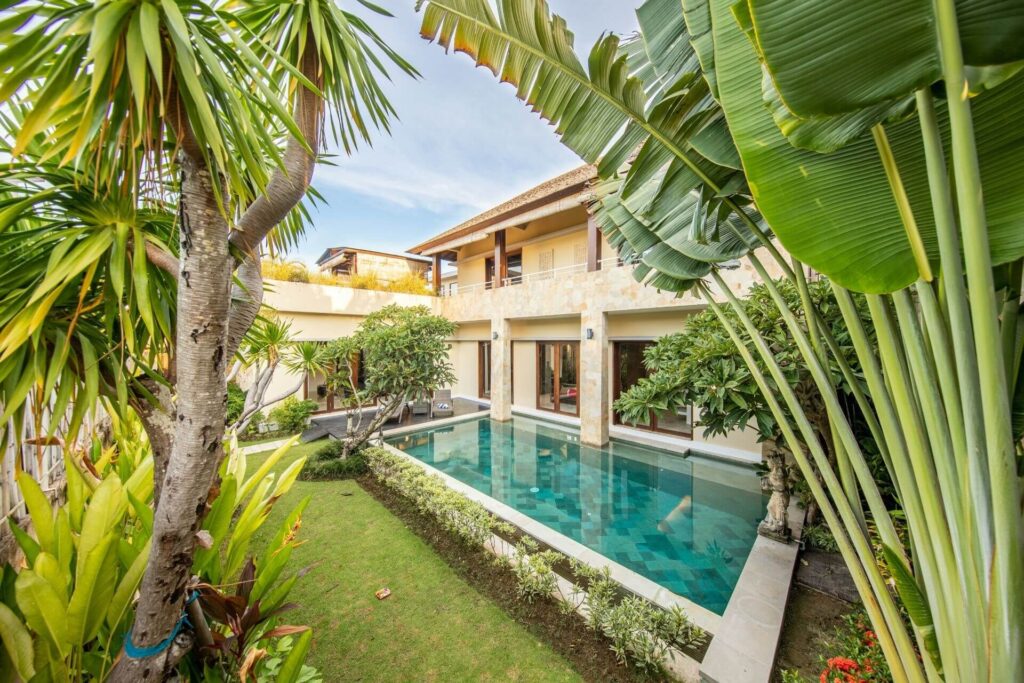Pools are a popular option for homeowners in 2025. However, people are going for more compact cold plunge pools instead of traditional large swimming pools. This trend spotlights a focus on wellness, turning backyards into private oases where clients can escape during a hot afternoon or enjoy an after-dark soak to unwind from the day.
The Growing Appeal of Cold Plunge Pools
Cold plunge pools are popular for their health benefits and the lower cost of building them. Traditional cold plunging involves submerging in icy lake waters at about 50 degrees Fahrenheit for 30 seconds to a minute. Since natural cold waters aren’t always available year-round, people have transitioned to DIY cold plunge pools installed in their homes.
Cold plunge benefits are well-documented, from reducing sore muscle pain to improving heart health. Beyond being a wellness therapy, these tubs offer landscape designers a unique opportunity to create a water feature that seamlessly blends into a client’s backyard, especially as more people look to transform their homes into personal wellness retreats.
Another benefit of a plunge pool is that the resale value of homes rises to 7% just by installing a pool since it’s an attractive feature for homeowners.
How to Select the Best Cold Plunge Pools
Cold plunge tubs come in different shapes, colors and sizes. The notion of “best” depends on how your clients envision the pools in their home oases. Do they want it to stand out, or do they prefer it to mesh with other elements in their surroundings?
These are the factors you need to consider.
1. Material
Since cold tubs are a smart health investment, choosing a material built to last is important. Popular options include plastic, stainless steel, concrete or fiberglass pools. Plastic is easier to maintain and more affordable but offers less insulation than other materials. You should also check with the homeowner’s overarching aesthetic to determine which option is best.
2. Size and Shape
Compact tubs are best for small spaces, while custom-built designs are ideal for seamless integration into the overall landscape. Consider the client’s space and how they want to use the pool. Do they prefer sitting? A round barrel tub works well for tight areas where people can squat and submerge in cold water. Larger options allow them to stretch their legs, similar to a regular bathtub.
3. Filtration and Maintenance
Some pools require more upkeep than others. Ideally, your clients will want something easy to clean and maintain. Some units filter water before it’s added to the tub, while others have an enhanced system where filters can be changed for each season. Some tubs are installed with jets that continuously circulate water and pass it through filters to keep them clean for longer.
Basic models are also easier to clean, requiring only draining and wiping down with water and a vinegar rinse. Some need upkeep every two to three weeks, while others need a weekly hosing. Let your clients know about the regular cleaning routine required for different types of pools.
4. Temperature Control
Cooling options vary widely from tub to tub. Electric units chill water by plugging them in, leaving them for a few hours and returning to an icy bath. Traditional options require you to haul ice bags to keep the water cool. More advanced systems include a useful temperature regulation feature and insulated covers to maintain it.
There are also varying cold plunge temperatures, ranging from 38 to 60 degrees Fahrenheit. Many clients prefer to dip a few times a week, so install one that doesn’t take hours of constant cooling for a great user experience.

Where to Place Plunge Pools
Accessibility is crucial when choosing the location for dipping pools. You want your clients to feel relaxed and at peace while using the tub, so striking a balance between aesthetics and functionality is essential.
If the yard has other wellness features, position the plunge pool near saunas, spas or outdoor showers. This creates a cohesive zone where the new addition complements the existing elements rather than feeling out of place.
Integrating the tub into the surrounding hardscaping is also essential. If you opt for an in-ground pool, you can make it in any shape or size, but since they’re permanent structures, you’ll have to consider if it benefits your long-term goal. On the other hand, aboveground soaking tubs can be moved from one place to another since they are usually portable, except the heavier ones.
Whether it’s an in-ground or aboveground pool, you want it to blend seamlessly. Consider using retaining walls, natural stone or wooden decking to create a smooth transition. Ensure the materials you choose are nonslip and provide a good grip when wet to maintain client safety.
If privacy is a concern, think about adding fences, hedges or decorative screens. These can help preserve the view of the yard while maintaining the homeowner’s privacy and security. Ultimately, the goal is to transform the space into a home oasis where the client can unwind without distractions or concerns.
How to Make Cold Plunge Pools More Eco-Friendly
Eco-conscious clients can appreciate additional sustainability features that reduce the environmental impact of a dipping pool, allowing them to indulge without guilt.
- Energy-efficient cooling: If the home is equipped with solar panels, linking the plunge pool to the system can help reduce energy consumption. To minimize power use further, consider solar-powered cooling systems or insulated pools.
- Water conservation: Since each plunge session requires a large amount, implementing a rainwater harvesting system can help fill the pool without depleting valuable resources or increasing water bills.
- Permeable hardscaping: Water runoff is inevitable as the tubs fill and users enter and exit. To prevent flooding and promote proper drainage, use permeable pavers or gravel around the soaking pool to minimize runoff and enhance drainage.
How to Harmonize the Pool With the Garden Landscape
Don’t let the tub stand out awkwardly in the landscape. Designers must focus on achieving visual and sensory harmony to integrate it into the garden design.
- Layered planting: A layered garden can help blend the plunge pool into its surroundings and soften harsh lines. Use a mix of ornamental grasses, flowering perennials and evergreen shrubs to create year-round interest around the tub.
- Aromatic herbs: Spas are renowned for their calming scents and soothing atmosphere. Replicate this effect by planting lavender, mint and rosemary around the pool area. These herbs will provide a natural fragrance that enhances the overall soak experience. Plants like citronella grass and marigolds are excellent mosquito repellents, perfect for poolside greenery.
This plant-focused approach makes the plunge pool feel like a natural extension of the garden rather than a stand-alone feature.

Wrap It Up With Landscape Lighting
The visual impact of a cold soaking pool doesn’t end when the sun sets. Thoughtful landscape lighting transforms the space into a nighttime sanctuary should homeowners decide to take an evening dip.
- Underwater LEDs: Install color-changing LED lights within the cold plunge pool to create subtle lighting. Underwater lighting also minimizes insects that get attracted to strong overhead lights.
- Path lighting: Use low-voltage, solar-powered lights to illuminate walkways leading to the pool. This feature enhances the overall soak experience by providing safety and ambience.
- Spotlighting: Highlight key plantings, hardscape elements or water features to add drama and depth. Warm lighting helps improve your mood as you dip compared to cool lights.
A well-lit plunge pool area invites relaxation at any hour while showcasing the design’s best elements.
Create the Perfect Backyard Sanctuary
Cold dipping pools offer a perfect fusion of wellness, design and functionality, making them a valuable addition to modern landscapes. Embracing the plunge pool mania positions professionals as industry trendsetters and can strengthen their landscaping portfolio.
Next time a client asks about the latest landscaping innovation, why not suggest a cold plunge pool? It’s a feature that turns any backyard into a sanctuary — and a conversation starter.

Leave a Reply